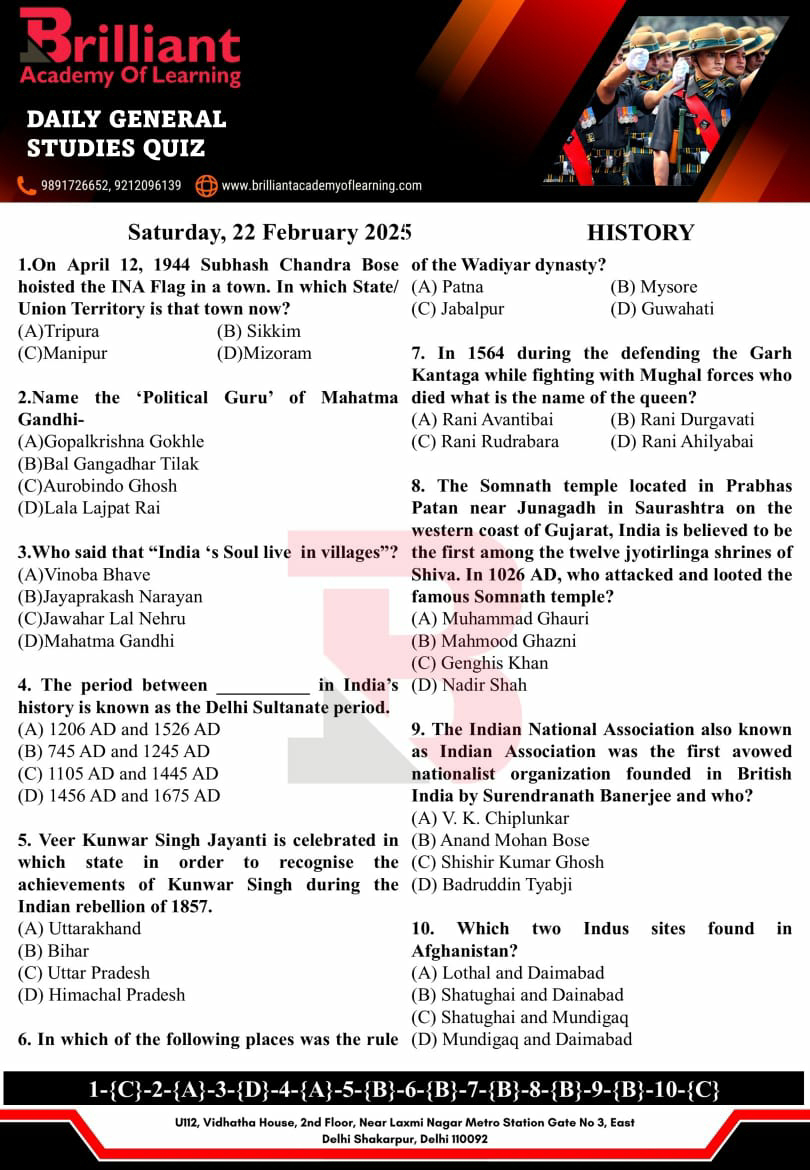Modern Indian History Questions explained in both Hindi and English (हिंदी और अंग्रेजी दोनों में)(Very Very Important) For Upcoming competitive Exams (Call9891726652) @BrilliantAcademyOfLearning - SSC, Railway, CDS, NDA,UPSC & State Civil Services
#MUST FOR SSC,DSSSB,RAILWAYS,CDS,NDA,CIVIL SERVICES#
Modern History
1. Who was successor of Maharaja Ranjit Singh?
Modern History
1. Who was successor of Maharaja Ranjit Singh?
Khadak Singh
महाराणा रणजीत सिंह के उत्तराधिकारी कौन थे — खड़क सिंह
2. Permanant Land Settlement is associated with - Lord Cornwalis
2. Permanant Land Settlement is associated with - Lord Cornwalis
‘स्थायी बंदोबस्त’ का सिद्धांत किसने दिया — लॉर्ड कॉर्नवालिस
3. Subsidiary Alliance is associated with - Lord Wellesley
3. Subsidiary Alliance is associated with - Lord Wellesley
‘सहायक संधि’ प्रणाली के जनक कौन थे — लॉर्ड वेलेजली
4.Who announced Queen Victoria Declaration? - Lord Canning
4.Who announced Queen Victoria Declaration? - Lord Canning
महारानी विक्टोरिया का घोषणा-पत्र किसने पढ़कर सुनाया — लॉर्ड कैनिंग
5. Ranjit Singh was related to which Misl of Sikhs? - Sukarchakiya
5. Ranjit Singh was related to which Misl of Sikhs? - Sukarchakiya
रण्जीत सिंह किस मिसल से संबंधित थे — सुकरचकिया
6.Who transferred his capital from Murshidabad to Monghyr? - Mir kasim
6.Who transferred his capital from Murshidabad to Monghyr? - Mir kasim
किसने अपनी राजधानी मुर्शिदाबाद से मुंगेर स्थापित की — मीर कासिम
7.Who was emperor of Delhi during Battle of Buxer (1764) and under whom English fought battle of Buxer ? - The Emperor of Delhi during Battle of Buxer was Shah Alam 2 and English fought under Hector Munroe.
7.Who was emperor of Delhi during Battle of Buxer (1764) and under whom English fought battle of Buxer ? - The Emperor of Delhi during Battle of Buxer was Shah Alam 2 and English fought under Hector Munroe.
बक्सर के युद्ध (1764 ई.) के समय दिल्ली का शासक कौन था और किसके नेतृत्व में अंग्रेजों ने ये लड़ाई की ? शाहआलम II उस समय मुगल बादशाह थे और अंग्रेजों ने ये लड़ाई हेक्टर मुनरो के नेतृत्व में लड़ी।
8. When Tipu Sultan died? Tipu Sultan died in 1799 during 4th Anglo Mysore battle.
8. When Tipu Sultan died? Tipu Sultan died in 1799 during 4th Anglo Mysore battle.
टीपू सुल्तान की मृत्यु कब हुई — 1799 ई. में चौथे अंग्रेज मैसूर युद्ध में।
9.What is Dindigul? Dindigul (Tamilnadu) is a famous for Strategic importance. An Arms Factory was established by Tipu Sultan here.
9.What is Dindigul? Dindigul (Tamilnadu) is a famous for Strategic importance. An Arms Factory was established by Tipu Sultan here.
डिंडीगुल क्या है — तमिलनाडु के एक शहर का नाम . यहां टीपू सुल्तान के द्वारा युद्ध के सामानों के निर्माण के लिए कारखाना स्थापित किया गया था।
10. During whose period Calcutta High Court was established? - Warren Hastings
10. During whose period Calcutta High Court was established? - Warren Hastings
किसके समय में कलकत्ता उच्च न्यायालय की स्थापना की गई — वॉरेन हेस्टिंग्स
11. During whose period expansion of British Indian Dominion finally ended? - Lord Dufferin
11. During whose period expansion of British Indian Dominion finally ended? - Lord Dufferin
ब्रिटिश भारतीय राज्य क्षेत्र के विस्तार का अंत किसके समय में हुआ — डफरिन के समय
12. Who suppressed Thugs? - Col. Sleemen during period of William Bentick.
12. Who suppressed Thugs? - Col. Sleemen during period of William Bentick.
ठगों का दमन किसने किया — कर्नल स्लीमेन , विलियम बैंटिक के काल में।
13. Who established rural Jats into Military Power? - Churaman
13. Who established rural Jats into Military Power? - Churaman
किसने ग्रामीण जाटों को एक सैनिक शक्ति के रूप में संगठित किया — चूरामन (चूड़ामणि)
14. Which Jat ruler is regarded Aftaloon,respected and scholar? - Surajmal
14. Which Jat ruler is regarded Aftaloon,respected and scholar? - Surajmal
किस जाट राजा को ‘जाटों का अफलातून एवं आदरणीय व विद्धान व्यक्ति’ कहा जाता है — सूरजमल
15. Who built fort of Louhgarh ? - Banda Bahadur
15. Who built fort of Louhgarh ? - Banda Bahadur
‘लौहगढ़’ नामक किला किसने बनवाया — बंदा बहादुर
16. On whose orders Banda Bahadur was killed ? - Farrukhsiyar
16. On whose orders Banda Bahadur was killed ? - Farrukhsiyar
किस मुगल बादशाह के आदेश पर बंदा बहादुर की हत्या की गई — फर्रुखसियर
17. Who was founder of Sikh state? - Ranjit Singh
17. Who was founder of Sikh state? - Ranjit Singh
पंजाब में सिख राज्य के संस्थापक कौन थे — रणजीत सिंह
18. After capturing which place Ranjit Singh took title of Maharaja ? - Lahore
18. After capturing which place Ranjit Singh took title of Maharaja ? - Lahore
रणजीत सिंह ने किस स्थान पर अधिकार करने के बाद ‘महाराजा’ की उपाधि धारण की — लाहौर
19. Which treaty was done between Ranjeet Singh and English? - Treaty of Amritsar
19. Which treaty was done between Ranjeet Singh and English? - Treaty of Amritsar
रणजीत सिंह व अंग्रेजों के बीच कौन-सी संधि हुई — अमृतसर की संधि
20.Which river was the boundary between Ranjeet Singh kingdom and English? - Sutlej river
20.Which river was the boundary between Ranjeet Singh kingdom and English? - Sutlej river
अमृतसर की संधि किस नदी के दोनों ओर के राज्य क्षेत्रों के बीच सीमा निर्धारित करती थी — सतलज नदी
भारत के किस गवर्नर जनरल के समय सिंध का विलय अंग्रेजी राज्य में किया गया — लॉर्ड एलनबरो
22. Who is credited with annexation of Sindh? - Lord Charles Napier
22. Who is credited with annexation of Sindh? - Lord Charles Napier
सिंध विजय का श्रेय किसे दिया जाता है — सर चाल्र्स नेपियर
23. Who gave birth to Subsidiary Alliance in India? - Duple
23. Who gave birth to Subsidiary Alliance in India? - Duple
भारत में सहायक संधि का जन्मदाता कौन है — डुप्ले
24. Who gave Subsidiary Alliance an extensive approach? - Lord Wellesley in 1798
24. Who gave Subsidiary Alliance an extensive approach? - Lord Wellesley in 1798
सहायक संधि को सुनिश्चित एवं व्यापक स्वरुप किसने प्रदान किया — लॉर्ड वेलेजली
25. Where was capital of Ranjeet Singh? - Lahore
25. Where was capital of Ranjeet Singh? - Lahore
पंजाब के राज रणजीत सिंह की राजधानी कहाँ थी — लाहौर
26. Doctrine of Lapse is associated with which Governor General? - Lord Dalhousie
26. Doctrine of Lapse is associated with which Governor General? - Lord Dalhousie
गोद प्रथा प्रतिबंध किस गवर्नर जनरल ने लगाया था — लॉर्ड डलहौजी ने
27. Danes established their company in India in which year? - 1616
27. Danes established their company in India in which year? - 1616
डेनमार्क की प्रथम व्यापारिक कंपनी का गठन कब हुआ — 1616 में
28. Board of Revenue was established in whose period?- Lord Hastings
28. Board of Revenue was established in whose period?- Lord Hastings
किसके काल में ‘बोर्ड ऑफ रेवन्यू’ की स्थापना हुई — हेस्टिंग्स के
29. Who is called Father of Indian Civil Services? - Lord Cornwalis
29. Who is called Father of Indian Civil Services? - Lord Cornwalis
किस अंग्रेज को प्रशासनिक सेवा का जनक कहा जाता है — कॉर्नवालिस को
कलकता में स्थित फोर्ट विलियम कॉलेज की स्थापना किसने की — लॉर्ड वेलेजली ने
31. Tenancy Act was introduced in which year? - 1822
31. Tenancy Act was introduced in which year? - 1822
टैंसी एक्ट या काश्तकारी अधिनियम कब लागू हुआ — 1822 में
32. When military mutiny started in Barrackpore?- 1824
32. When military mutiny started in Barrackpore?- 1824
बैरकपुर में सैन्य विद्रोह कब आरंभ हुआ — 1824 में
33. Which Governor General 's period is known for Educational Reforms ?- Lord William Bentick (Macaulay minutes on Education in 1833)
33. Which Governor General 's period is known for Educational Reforms ?- Lord William Bentick (Macaulay minutes on Education in 1833)
किस गर्वनर जनरल का कार्यकाल शिक्षा सुधारों के लिए माना जाता है — विलियम बैंटिंक(मैकाले रिपोर्ट 1833)
34. Who established Calcutta Medical College? - In 1835 , Lord William Bentick
34. Who established Calcutta Medical College? - In 1835 , Lord William Bentick
कलकत्ता मेडिकल कॉलेज की स्थापना कब और किसने की — 1835 ई., विलियम बैंटिंक ने
35. Who prohibited Female Child Infanticide? During the period of Lord William Bentick in 1830
35. Who prohibited Female Child Infanticide? During the period of Lord William Bentick in 1830
बालिका हत्या पर प्रतिबंध कब लगाया गया — 1830 में लार्ड विलियम बैंटिक द्वारा
36. Who is called Liberator of Indian press ? Charles Metcalfe
36. Who is called Liberator of Indian press ? Charles Metcalfe
किसे ‘भारतीय प्रेस का मुक्तिदाता’ कहा जाता है — लॉर्ड चाल्र्स मेटकॉफ को
37. Who established Inam commission?- Lord Dalhousie
37. Who established Inam commission?- Lord Dalhousie
‘इनाम कमीशन’ की स्थापना किसने की — लॉर्ड डलहौजी ने
38. Under which Tax system 50% of Land produce was taken during British Period? - Ryotwari System
38. Under which Tax system 50% of Land produce was taken during British Period? - Ryotwari System
किस कर व्यवस्था के अंतर्गत किसानों से उपज का 50% वसूला जाता था — रैयतवाड़ी व्यवस्था
39. Human Sacrifice was prohibited during which Governor General? - Lord William Bentick
39. Human Sacrifice was prohibited during which Governor General? - Lord William Bentick
नरबलि प्रथा का अंत किस गवर्नर के काल में हुआ — लार्ड विलियम बैंटिक
40. Drain Theory of Wealth was propounded by which leader? - Dadabhai Naoroji in his book Poverty and Unbritish Rule of India. In this book he described how British were extracting wealth from India.
40. Drain Theory of Wealth was propounded by which leader? - Dadabhai Naoroji in his book Poverty and Unbritish Rule of India. In this book he described how British were extracting wealth from India.
भारत से ब्रिटेन की ओर ‘संपत्ति के अपवहन’ का सिद्धांत किसने प्रतिपादित किया — दादाभाई नौरोजी ने अपने पुस्तक पॉवर्टी ऐंड अनब्रिटिश रूल ऑफ इंडिया में बताया की अंग्रेज किस प्रकार से भारत से धन का निष्कासन कर रहे हैं।
41. Who ,when and where started Telegraph line in India? - During the period of Lord Dalhousie first Telegraph line was started in 1854 between Calcutta and Agra.
41. Who ,when and where started Telegraph line in India? - During the period of Lord Dalhousie first Telegraph line was started in 1854 between Calcutta and Agra.
भारत में टेलीग्राफ लाइन किसके द्वारा शुरू की गई — कलकत्ता व आगरा में लार्ड डलहौजी के समय में 1854 में।
42. First cotton mill was started by whom and where in India? - First Cotton Mill in Calcutta in 1818 near Fort Galster but large manufacturing started in Bombay (Bombay Spinning and Weaving Company)in 1854 .
42. First cotton mill was started by whom and where in India? - First Cotton Mill in Calcutta in 1818 near Fort Galster but large manufacturing started in Bombay (Bombay Spinning and Weaving Company)in 1854 .
भारत में पहली सूती वस्त्र मिल कहाँ स्थापित की गई — पहले कलकत्ता में 1818 में लेकिन बड़े स्तर पर मुंबई में 1854 में।
43. After which battle English started looting India? After Battle of pallassey (1757)
43. After which battle English started looting India? After Battle of pallassey (1757)
भारत में अंग्रेजों की लूट किस महत्वपूर्ण घटना के बाद शुरू हुई — प्लासी के युद्ध के बाद(1757)
44. First Railway line was laid by whom? George Clark in 1853 from Bombay to Thane 34 km track during the period of Lord Dalhousie.
44. First Railway line was laid by whom? George Clark in 1853 from Bombay to Thane 34 km track during the period of Lord Dalhousie.
भारत में प्रथम रेलवे लाइन किसने बिछवाई — जार्ज क्लार्क द्वारा बॉम्बे से थाने के बीच 34 km का ट्रैक 1853 में लार्ड डलहौजी के समय में।
45. Who got maximum benefits of British Land Revenue System? - Landlords/Zamindars
45. Who got maximum benefits of British Land Revenue System? - Landlords/Zamindars
भारत में ब्रिटिश भू-राजस्व प्रणाली का अधिक लाभ किसे प्राप्त हुआ — जमींदार
46. Permanant Land Settlement in Bihar and Bengal was introduced by whom ? - Lord Cornwalis in 1793
46. Permanant Land Settlement in Bihar and Bengal was introduced by whom ? - Lord Cornwalis in 1793
किसके द्वारा बंगाल व बिहार में स्थाई बंदोबस्त का शुभारम्भ किया गया — लॉर्ड कॉर्नवालिस
47. When was Ryotwari Settlement introduced? By Thomas Munroe in Madras, Bombay,Assam ,Coorg in 1820.
47. When was Ryotwari Settlement introduced? By Thomas Munroe in Madras, Bombay,Assam ,Coorg in 1820.
रैयतवाडत्री व्यवस्था कब लागू की गई — थोमस मुनरो मद्रास, बॉम्बे, असम, कुर्ग में 1820 ई. में।
48. When was Mahalbari Settlement introduced? - By Lord Mackenzie in North West Frontier,Agra, Central Provinces ,Punjab in 1822 and reviewed during period of Lord William Bentick.
48. When was Mahalbari Settlement introduced? - By Lord Mackenzie in North West Frontier,Agra, Central Provinces ,Punjab in 1822 and reviewed during period of Lord William Bentick.
पहली बार औपचारिक रूप से महालवाड़ी प्रथा कब लागू की गई — 1822 ई. में उत्तर पश्चिम सीमावर्ती प्रांत, आगरा, मध्य प्रांत, पंजाब में लार्ड मैकेंजी द्वारा । बाद में लार्ड विलियम बैंटिक द्वारा इसमें संशोधन किए गए।
49. What was the sequence of Europeans arrival in Modern India? भारत में यूरोपियन के आगमन का क्रम क्या है ?
(1) Portugese (1498) Vascodagama reached Calicut,Kerala during the rule of Zamorin. He discovered a new sea route from Europe to India.
(2) Dutch (1605)
(3) English (1608)
(4) Danes (1620)
(5) French (1668)
50. What was the sequence of Opening of Factories by Europeans to trade with East (India)? यूरोपियन कंपनीज द्वारा पूरब (भारत ) से व्यापार के लिए स्थापित कंपनीज का क्रम क्या है ?
1. Portuguese opened their first factory in India in (1500,Calicut, Kerala)
2. English East India company was established in 1600 but they established their first factory in Surat,Gujrat in 1615.
3.Dutch East India company was established in 1602 but they opened their first factory in India in Masulipatnam (Andhrapradesh) in 1605.
4. Danes established their first factory in Tranqubar (Tamilnadu) in 1620. Although Danish East India company was established in 1616.
5. French East India company was established in 1664.French established their first factory in India in Surat(Gujarat) in 1668.
51. Who is called Father of Local Self Government?
Lord Ripon is called Father of Local Self Government.
52. Who is called Father of English Education in India?
Lord Macaulay
53. Who is associated with Vernacular Press Act?
Lord Lytton
Call 7678518506/9891726652 for any query about preparation for SSC Bank CDS Airforce X Y NAVY SSR AA MR AFCAT NDA, Delhi police, & General competitions





Comments
Post a Comment